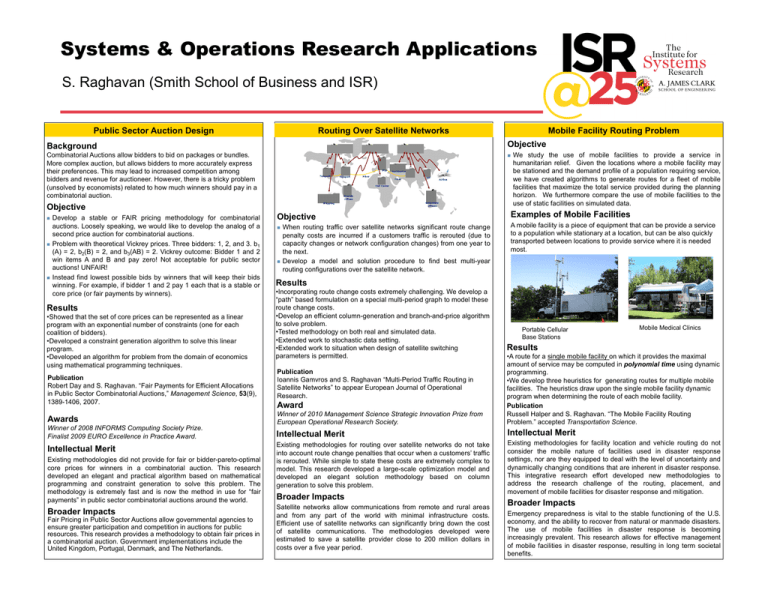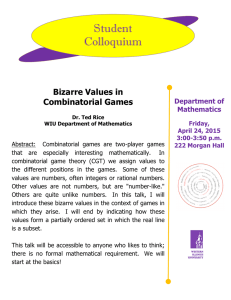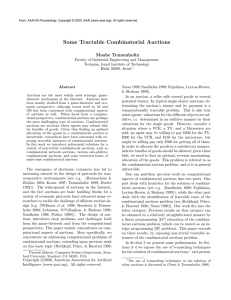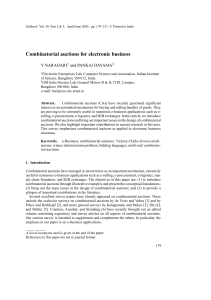Systems & Operations Research Applications Public Sector Auction Design
advertisement

Systems & Operations Research Applications S. Raghavan (Smith School of Business and ISR) Public Sector Auction Design Routing Over Satellite Networks Mobile Facility Routing Problem Background Objective Combinatorial Auctions allow bidders to bid on packages or bundles. More complex auction, but allows bidders to more accurately express their preferences. This may lead to increased competition among bidders and revenue for auctioneer. However, there is a tricky problem (unsolved by economists) related to how much winners should pay in a combinatorial auction. Objective Develop a stable or FAIR pricing methodology for combinatorial auctions. Loosely speaking, we would like to develop the analog of a second price auction for combinatorial auctions. Problem with theoretical Vickrey prices. Three bidders: 1, 2, and 3. b1 (A) = 2, b2(B) = 2, and b3(AB) = 2. Vickrey outcome: Bidder 1 and 2 win items A and B and pay zero! Not acceptable for public sector auctions! UNFAIR! Instead find lowest possible bids by winners that will keep their bids winning. For example, if bidder 1 and 2 pay 1 each that is a stable or core price (or fair payments by winners). Results • Showed that the set of core prices can be represented as a linear program with an exponential number of constraints (one for each coalition of bidders). • Developed a constraint generation algorithm to solve this linear program. • Developed an algorithm for problem from the domain of economics using mathematical programming techniques. Publication Robert Day and S. Raghavan. “Fair Payments for Efficient Allocations in Public Sector Combinatorial Auctions,” Management Science, 53(9), 1389-1406, 2007. Awards Winner of 2008 INFORMS Computing Society Prize. Finalist 2009 EURO Excellence in Practice Award. Intellectual Merit Existing methodologies did not provide for fair or bidder-pareto-optimal core prices for winners in a combinatorial auction. This research developed an elegant and practical algorithm based on mathematical programming and constraint generation to solve this problem. The methodology is extremely fast and is now the method in use for “fair payments” in public sector combinatorial auctions around the world. Broader Impacts Fair Pricing in Public Sector Auctions allow governmental agencies to ensure greater participation and competition in auctions for public resources. This research provides a methodology to obtain fair prices in a combinatorial auction. Government implementations include the United Kingdom, Portugal, Denmark, and The Netherlands. Objective When routing traffic over satellite networks significant route change penalty costs are incurred if a customers traffic is rerouted (due to capacity changes or network configuration changes) from one year to the next. Develop a model and solution procedure to find best multi-year routing configurations over the satellite network. We study the use of mobile facilities to provide a service in humanitarian relief. Given the locations where a mobile facility may be stationed and the demand profile of a population requiring service, we have created algorithms to generate routes for a fleet of mobile facilities that maximize the total service provided during the planning horizon. We furthermore compare the use of mobile facilities to the use of static facilities on simulated data. Examples of Mobile Facilities A mobile facility is a piece of equipment that can be provide a service to a population while stationary at a location, but can be also quickly transported between locations to provide service where it is needed most. Results • Incorporating route change costs extremely challenging. We develop a “path” based formulation on a special multi-period graph to model these route change costs. • Develop an efficient column-generation and branch-and-price algorithm to solve problem. • Tested methodology on both real and simulated data. • Extended work to stochastic data setting. • Extended work to situation when design of satellite switching parameters is permitted. Portable Cellular Base Stations Mobile Medical Clinics Results Winner of 2010 Management Science Strategic Innovation Prize from European Operational Research Society. • A route for a single mobile facility on which it provides the maximal amount of service may be computed in polynomial time using dynamic programming. • We develop three heuristics for generating routes for multiple mobile facilities. The heuristics draw upon the single mobile facility dynamic program when determining the route of each mobile facility. Publication Russell Halper and S. Raghavan. “The Mobile Facility Routing Problem.” accepted Transportation Science. Intellectual Merit Intellectual Merit Existing methodologies for routing over satellite networks do not take into account route change penalties that occur when a customers’ traffic is rerouted. While simple to state these costs are extremely complex to model. This research developed a large-scale optimization model and developed an elegant solution methodology based on column generation to solve this problem. Existing methodologies for facility location and vehicle routing do not consider the mobile nature of facilities used in disaster response settings, nor are they equipped to deal with the level of uncertainty and dynamically changing conditions that are inherent in disaster response. This integrative research effort developed new methodologies to address the research challenge of the routing, placement, and movement of mobile facilities for disaster response and mitigation. Publication Ioannis Gamvros and S. Raghavan “Multi-Period Traffic Routing in Satellite Networks” to appear European Journal of Operational Research. Award Broader Impacts Satellite networks allow communications from remote and rural areas and from any part of the world with minimal infrastructure costs. Efficient use of satellite networks can significantly bring down the cost of satellite communications. The methodologies developed were estimated to save a satellite provider close to 200 million dollars in costs over a five year period. Broader Impacts Emergency preparedness is vital to the stable functioning of the U.S. economy, and the ability to recover from natural or manmade disasters. The use of mobile facilities in disaster response is becoming increasingly prevalent. This research allows for effective management of mobile facilities in disaster response, resulting in long term societal benefits.




